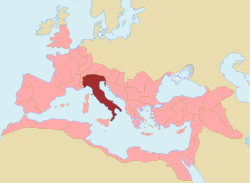
Back Italia (Romeinse Ryk) Afrikaans إيطاليا الرومانية Arabic Італія (рымская правінцыя) Byelorussian Италия (римска провинция) Bulgarian Itàlia romana Catalan Italia (talaith Rufeinig) Welsh Romersk Italien Danish Römisches Italien German Ρωμαϊκή Ιταλία Greek Italia (Romia Imperio) Esperanto
Italy Italia (Latin) | |||||||||
|---|---|---|---|---|---|---|---|---|---|
| 264 BC–476 | |||||||||
 Roman Empire at its greatest extent (c. 117 AD), with Italy in red and provinces in pink | |||||||||
| Capital | Rome: full-fledged until Diocletianic times, from then on mostly only de jure. Mediolanum and Ravenna: Imperial residences; de facto capital in the Late Empire (of the whole Empire or only the Western part) | ||||||||
| Common languages | Latin | ||||||||
| Religion | Roman polytheism, followed by Nicene- Chalcedonian Christianity | ||||||||
| Government | Mixed constitution | ||||||||
| Legislature | Senate and People of Rome | ||||||||
| Historical era | Classical Antiquity, Late Antiquity | ||||||||
• Established | 264 BC | ||||||||
• Disestablished | 476 | ||||||||
| Population | |||||||||
• AD 1 | Estimates vary from 4 to 10 million (c. 1 million in Rome)[1][2] | ||||||||
| ISO 3166 code | IT | ||||||||
| |||||||||
| History of Italy |
|---|
 |
|
|
Italia (in both the Latin and Italian languages), also referred to as Roman Italy, was the homeland of the ancient Romans.[3][4][5][6] According to Roman mythology, Italy was the ancestral home promised by Jupiter to Aeneas of Troy and his descendants, Romulus and Remus, who were the founders of Rome. Aside from the legendary accounts, Rome was an Italic city-state that changed its form of government from Kingdom to Republic and then grew within the context of a peninsula dominated by the Gauls, Ligures, Veneti, Camunni and Histri in the North, the Etruscans, Latins, Falisci, Picentes and Umbri tribes (such as the Sabines) in the Centre, and the Iapygian tribes (such as the Messapians), the Oscan tribes (such as the Samnites), and Greek colonies in the South.
The consolidation of Italy into a single entity occurred during the Roman expansion in the peninsula, when Rome formed a permanent association with most of the local tribes and cities.[7] The strength of the Italian confederacy was a crucial factor in the rise of Rome, starting with the Punic and Macedonian wars between the 3rd and 2nd century BC. As Roman provinces were being established throughout the Mediterranean, Italy maintained a special status with political, religious and financial privileges.[8][9][10] In Italy, Roman magistrates exercised the imperium domi (police power) as an alternative to the imperium militiae (military power). Italy's inhabitants included Roman citizens, communities with Latin Rights, and socii.
The period between the end of the 2nd century BC and the 1st century BC was turbulent, beginning with the Servile Wars, continuing with the opposition of aristocratic élite to populist reformers and leading to a Social War in the middle of Italy. However, Roman citizenship was recognized to the rest of the Italians by the end of the conflict and then extended to Cisalpine Gaul when Julius Caesar became Roman dictator. In the context of the transition from Republic to Principate, Italy swore allegiance to Octavian Augustus and was then organized in eleven regions from the Alps to the Ionian Sea with more than two centuries of stability afterward. Several emperors made notable accomplishments in this period: Claudius incorporated Britain into the Roman Empire, Vespasian subjugated the Great Revolt of Judea and reformed the financial system, Trajan conquered Dacia and defeated Parthia, and Marcus Aurelius epitomized the ideal of the philosopher king.
The Crisis of the Third Century hit Italy particularly hard, but the Roman Empire managed to survive and reconquer breakaway regions. In 286 AD, the Emperor Diocletian moved the imperial residence associated with the western provinces (the later Western Roman Empire) from Rome to Mediolanum.[11] Meanwhile, the islands of Corsica, Sardinia, Sicily and Malta were added to Italy by Diocletian in 292 AD, and Italian cities such as Mediolanum and Ravenna continued to serve as de facto capitals for the West. Although, in late antiquity, Italy was also sub-divided into provinces, it remained the centre of the Western Roman Empire. The Bishop of Rome had gained importance gradually from the reign of Constantine, and was given religious primacy with the Edict of Thessalonica under Theodosius I. Italy was invaded several times by the wandering Germanic peoples and fell under the control of Odoacer, when Romulus Augustus was deposed in 476 AD. Since then, no single authority was established in Italy as a whole except for a brief Period when the Byzantine Empire reconquered Italy. Even the modern Republic of Italy only consists of most of Italian region, excluding Corsica and some other areas.
- ^ Journal of Roman Archaeology, Volume 18, Part 1
- ^ Ligt, Luuk de; Northwood, S. J. (2008). People, Land, and Politics: Demographic Developments and the Transformation of Roman Italy 300 BC-AD 14. ISBN 978-9004171183.
- ^ Dyson, Stephen L. (14 July 2014). The Creation of the Roman Frontier. ISBN 9781400854899.
- ^ Hannibal's war, by J. F. Lazenby
- ^ Bleicken, Jochen (15 October 2015). Augustus: The Biography. ISBN 9780241003909.
- ^ Rogers, Lester Burton; Adams, Fay; Brown, Walker (1956). "Story of Nations".
- ^ Mommsen, Theodor (1855). History of Rome, Book II: From the Abolition of the Monarchy in Rome to the Union of Italy. Leipzig: Reimer & Hirsel.
- ^ A. Fear; P. Liddel, eds. (2010). "The Glory of Italy and Rome's Universal Destiny in Strabo's Geographika". Historiae Mundi. Studies in Universal History. London: Duckworth. pp. 87–101. Retrieved 20 November 2021.
- ^ Keaveney, Arthur (January 1987). Arthur Keaveney: Rome and the Unification of Italy. ISBN 9780709931218. Retrieved 20 November 2021.
- ^ Billanovich, Giuseppe (2008). Libreria Universitaria Hoepli, Lezioni di filologia, Giuseppe Billanovich e Roberto Pesce: Corpus Iuris Civilis, Italia non erat provincia, sed domina provinciarum, Feltrinelli, p.363 (in Italian). ISBN 9788896543092. Retrieved 20 November 2021.
- ^ Video of Roman Milan (in Italian)